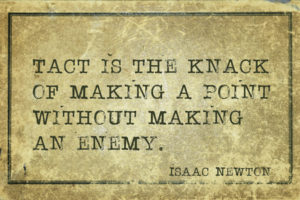By Rose O. Sherman, EdD, RN, FAAN
One of my students told me a story of how her CNO had spoken with her about the lack of tact that she was demonstrating in leadership meetings. She was a little resentful about the conversation when it seemed that the CNO was pointing out something that could help her in furthering her relationships with others. “It is who I am“, she told me – “what you see is what you get“. I asked her whether she felt this approach was working for her and she acknowledged that sometimes she did inadvertently cause conflict. Prolonged extreme tactlessness can result in decreased communication, damage to relationships and conflict. While it may have seemed to my student that she being direct and telling the absolute truth is always the right route, sometimes it is not.
What is Tact?
Tact is the ability to tell the truth in a way that takes into account other people’s feelings and reactions. It allows you to give difficult feedback, communicate sensitive information, and say the right thing to preserve a relationship.The late President Truman once said that “tact is the ability to step on a man’s toes without messing up the shine on his shoes.” This is good advice because wise leaders know that they must always confront things in the most diplomatic way possible to achieve the best results. Before you confront anyone, take time for yourself and review the situation; ask yourself what happened here, for what reason, and what needs to change. Using tact allows you to avoid conflict, find common ground, and allow others to save face. It can therefore be an important asset in negotiations and in conflict resolution.
Key Ways to be More Tactful
1. Think before you speak and choose the right environment to get your point across.
2. Pay attention to your timing
3. Choose your words carefully
4. Control your body language
5. Never react when emotional – especially anger
Examples of Tactless Statements to Avoid
* You need to do better next time……… using a pointed you in the conversation will always put the other person on the defensive.
* No offense but…….what follows this statement is usually offensive so it shuts down the conversation.
* Saying an outright NO to an invitation ………can be offensive to the other person. Instead say thanks for thinking of me but I cannot come or cannot do it says yes to the person but no to the invitation.
* You don’t know what you are talking about ……….. dismisses the opinion of the other. Instead say I see things differently and here is why or let’s agree to disagree on this.
* What have you been doing all day ………. suggests that the staff member has been wasting their time. Instead ask them to talk about what they have done today.
* Well, I just assumed ……… anything that follows this usually implies that something is missing or has been left undone.
* That’s not how we do things around here …….. shuts down any new ideas.
* Your procrastination is not my emergency …….. makes the assumption that there is no good reason to expedite a request.
The ability to communicate with diplomacy and tact is a difficult skill to master but one that every leader needs to hone. While as a human being you may feel to express your emotions; as a leader you need to sacrifice this and avoid negative emotions that you might feel around your team. It is important to your leadership success.
Read to Lead
Mindtools (2017). How to be tactful: Responding with Diplomacy and Grace
© emergingrnleader.com 2017



 LinkedIn
LinkedIn Instagram
Instagram